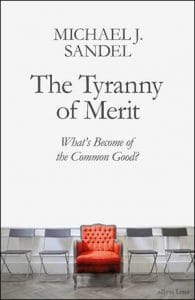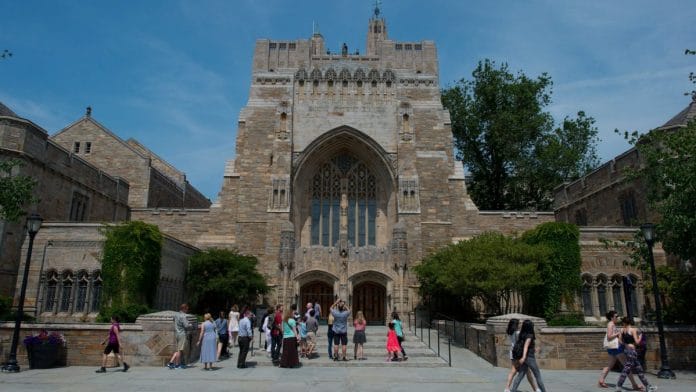First, the SAT, it turns out, does not measure scholarly aptitude or native intelligence independent of social and educational background. To the contrary, SAT scores are highly correlated with wealth. The higher your family income, the higher your SAT score. At each successive rung on the income ladder, average SAT scores increase. For scores that put students in contention for the most selective colleges, the gap is especially stark. If you come from a family with an annual income greater than $200,000, your chance of scoring above 1400 (out of 1600) is one in five. If you come from a poor family (less than $20,000 per year), your chance is one in fifty. Those in high-scoring categories are also, overwhelmingly, children of parents with college degrees.
Beyond the general educational advantages well-off families can provide, the SAT scores of the privileged are boosted by the use of private test- prep courses and tutors. Some, in places like Manhattan, charge as much as $1,000 per hour for one-on-one tutoring. As meritocratic competition for college admission has intensified in recent decades, tutoring and test prep has become a billion-dollar industry.
For years, the College Board, which administers the SAT, insisted that its test measured aptitude and that scores were unaffected by tutoring. It recently dropped that pretense and entered a partnership with the Khan Academy to provide free online SAT practice to all test takers. Although this was a worthy undertaking, it did little to level the test-prep playing field, as College Board officials hoped and claimed it would. Unsurprisingly perhaps, students from families with higher incomes and education levels made greater use of the online help than did students from disadvantaged backgrounds, resulting in an even greater scoring gap between the privileged and the rest.
For James Bryant Conant, an American chemist and former president of Harvard University, a test of aptitude or IQ held promise as a democratic measure of academic ability, untainted by educational disadvantage and the vagaries of high school grades. This is why he opted for the SAT to choose his scholarship students. He would be surprised to learn that high school grades are better than SAT scores at identifying low-income students who are likely to succeed in college.
While high school grades are to some extent correlated with family income, SAT scores are more so. This is partly because, contrary to long-standing claims by the testing industry, the SAT is coachable. Private tutoring helps, and a profitable industry has arisen to teach high school students the gimmicks and tricks to boost their scores.
Also read: Ivy League universities offer free online courses amid Covid-19 lockdown
Meritocracy entrenches inequality
Second, the system of meritocratic admission that Conant promoted did not lead to the classless society he hoped it would produce. Inequalities of income and wealth have deepened since the 1940s and 1950s, and the social mobility that Conant saw as the remedy for a stratified society has not come about. The haves and have-nots have not been trading places from one generation to the next. As we have seen, relatively few children of the poor rise to affluence, and relatively few children of affluence fall below the ranks of the upper-middle class. Notwithstanding the American dream of rising from rags to riches, upward mobility is less common in the United States than in many European countries, and there is no evidence of improvement in recent decades.
The favoritism that Harvard, Yale, and Princeton long accorded young men from upper-class boarding schools receded in the 1960s and 1970s. So did the routine admission to Ivy League colleges of any minimally qualified son of an alumnus. Academic standards improved and median SAT scores increased. The best-endowed colleges and universities adopted need-blind admissions and generous financial-aid policies, removing a major financial barrier for promising students of modest means.
These are the undeniable achievements. And yet, the meritocratic revolution in higher education did not bring about the social mobility and broad opportunity that its early proponents expected and that educational leaders and politicians continue to promise. America’s selective colleges and universities ousted the complacent, entitled, hereditary elite that worried Conant. But this aristocracy of inherited privilege has given way to a meritocratic elite that is now as privileged and entrenched as the one it replaced.
Though far more inclusive in terms of gender, race, and ethnicity, this meritocratic elite has not produced a fluid, mobile society. Instead, today’s credentialed, professional classes have figured out how to pass their privileges on to their children, not by bequeathing them large estates but by equipping them with the advantages that determine success in a meritocratic society.
Notwithstanding its newfound role as the arbiter of opportunity and the engine of upward mobility, higher education has not provided a significant counterweight to the rising inequality of recent times. Consider the class composition of higher education today, especially in its most selective domains:
- Most students at selective colleges and universities are from affluent families; very few are from low-income backgrounds. More than 70 percent of those who attend the hundred or so most competitive colleges in the United States come from the top quarter of the income scale; only 3 percent come from the bottom quarter.
- The wealth gap in college enrollment is most acute at the top. At Ivy League colleges, Stanford, Duke, and other prestigious places, there are more students from the wealthiest 1 percent of families than from the entire bottom half of the country. At Yale and Princeton, only about one student in fifty comes from a poor family (bottom 20 percent).
- If you come from a rich family (top 1 percent), your chances of attending an Ivy League school are 77 times greater than if you come from a poor family (bottom 20 percent). Most young people from the bottom half of the income scale attend a two-year college or none at all.
Also read: IIT, IISc global rankings fall: How can India attract foreign students, faculty to improve?
Over the last two decades, elite private colleges have offered more generous financial aid, and the federal government has increased college funding for students of modest means. Harvard and Stanford, for example, now provide free tuition, room, and board to any student whose family makes less than $65,000 per year. Despite these measures, however, the share of students from low-income families at selective colleges has changed little since 2000 and in some cases has drifted downward. The percentage of “first generation” students (the first in their families to attend college) at Harvard today is no higher than it was in 1960. Jerome Karabel, the author of a history of admissions policies at Harvard, Yale, and Princeton, concludes that “the children of the working class and the poor are about as unlikely to attend the Big Three [Harvard, Yale, and Princeton] today as they were in 1954.”
Why elite colleges are not engines of mobility
The academic reputations, scientific contributions, and rich educational offerings of America’s leading colleges and universities are admired throughout the world. But these institutions are not effective engines of upward mobility. Recently, the economist Raj Chetty and a team of colleagues undertook a comprehensive study of the role of colleges in promoting intergenerational mobility, examining the economic trajectory of 30 million college students from 1999 to 2013. For each college in the United States, they calculated the proportion of its students who rose from the bottom rung on the income ladder to the top (i.e., from the bottom quintile to the top quintile). They asked, in other words, what proportion of students at each college came from a poor family but wound up earning enough to reach the top 20 percent. Their finding: higher education today does surprisingly little to promote upward mobility.
This is especially true at elite private colleges. Although attending a place like Harvard or Princeton does give a poor kid a good chance of rising, such places enroll so few poor kids to begin with that their mobility rate is low. Only 1.8 percent of Harvard students (and only 1.3 percent at Princeton) rise from the bottom to the top of the income scale.
One might expect things to be different at the major public universities. But they, too, enroll so many already-affluent students that they contribute little to upward mobility.
Taken together, the 1,800 colleges and universities Chetty studied—private and public, selective and non-selective—enabled fewer than 2 percent of their students to rise from the bottom fifth of the income scale to the top fifth. Some might ask whether propelling students, in one generation, from the bottom quintile ($20,000 family income or less) to the top ($110,000 income or more) is too demanding a test of mobility. But even more modest ascents are relatively rare. At elite private colleges and universities, only about one student in ten manages to rise even two rungs (two quintiles) on the income ladder.
American colleges and universities enable surprisingly few students to rise, despite the fact that attending such places does enhance one’s economic prospects. College graduates, especially from prestigious places, do have a major edge in landing lucrative jobs. But these schools have little impact on upward mobility, because most of their students are well-off in the first place. American higher education is like an elevator in a building that most people enter on the top floor.
Also read: UPSC, JEE-NEET, robotics — you can study for almost everything online in India now
In practice, most colleges and universities do less to expand opportunity than to consolidate privilege. For those who look to higher education as the primary vehicle of opportunity, this is sobering news. It calls into question an article of faith in contemporary politics—that the answer to rising inequality is greater mobility, and that the way to increase mobility is to send more people to college.

This excerpt from The Tyranny of Merit by Michael J. Sandel has been published with special permission from Penguin Randomhouse.







Should we redefine what aptitude is?
What are the low income students majoring in? Do they have IQ, SKILLS needed to earn a degree in high paying field? Going to Harvard and majoring in humanities will not raise your earnings.
This is happening in India too.
Private tuitions give an edge to well to do students.
A student who is doing self study obviously in the long run will lag behind
Interesting article. It would be interested to know these comparisons with Middle class families as well.
That’s why MIT, Caltech and U Chicago have better quality of enrolled student.
How sir? …They are still focussed on families whose income in Indian currency is above 2 lakh, middle class families here have a income bellow 1 lakh which is $3500 in your sight , but we have merits here , what now?….this is how money rules over merits!